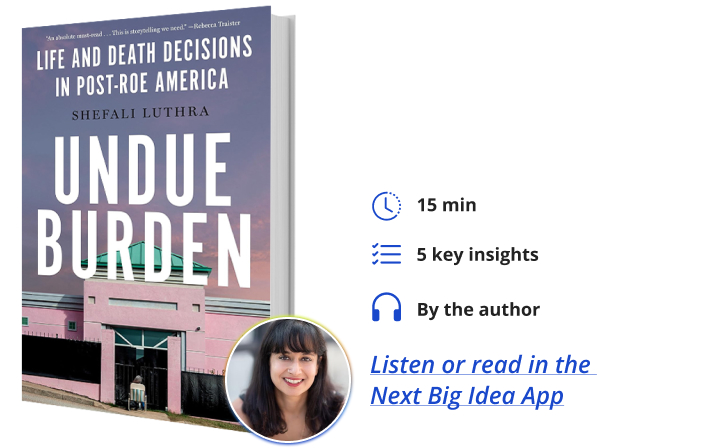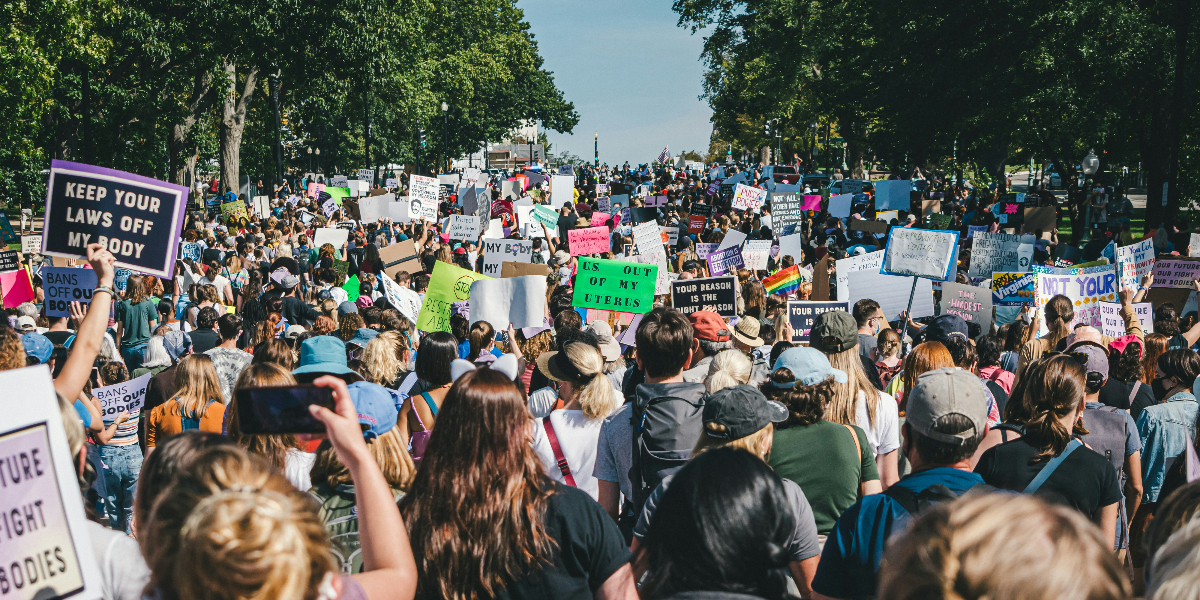Shefali Luthra has covered national health policy for the past decade, most recently at The 19th. Her coverage of abortion rights has been cited in Congressional testimony and Supreme Court briefings and in 2023 received an Online Journalism Award. Luthra’s writing has appeared in The New York Times, The Washington Post, NPR, and more.
Below, Shefali shares five key insights from her new book, Undue Burden: Life and Death Decisions in Post-Roe America. Listen to the audio version—read by Shefali herself—in the Next Big Idea App.

1. The fall of Roe has affected every state in America, even those that protect the right to abortion.
Since Roe v. Wade fell in June 2022, abortion has been made illegal or heavily restricted in 21 states. However, the impact extends to virtually every state in the country.
That’s in part because of how fragile the American reproductive healthcare network already was. With clinics shuttering in states with bans, pregnant people have crisscrossed the country to find abortions elsewhere. That’s meant longer wait times for abortions, sometimes multiple weeks for an appointment. It also means fewer physicians have the bandwidth to provide other forms of health care: pap smears, colposcopies, and contraception, just to name a few. As more bans and stricter bans take effect, the burdens on the system will only grow—and more people will feel the impact.
The fall of Roe has also emboldened the anti-abortion movement to develop strategies for federal abortion restrictions. That could mean national bans on certain medications used for abortions and for miscarriage treatment. It could also mean resuscitating an 1873 law to outlaw abortion entirely. Those kinds of bans would overrule any state-specific abortion protections.
2. Even before the Supreme Court struck down Roe v. Wade, the right to an abortion was already a right in name only throughout much of America.
Even when Roe was intact, many states had worked hard to undercut abortion rights. In Mississippi, only one clinic in Jackson provided the procedure, and only up to 16 weeks. Anti-abortion centers—taxpayer-funded, usually religious organizations that rely on inaccurate information to discourage people from ending their pregnancies—vastly outnumbered abortion clinics. Federal dollars were not allowed to be used to fund abortion. In most states, Medicaid, the insurance program for low-income people, didn’t cover the procedure, which, at its cheapest, could cost several hundred dollars.
“Even when Roe was intact, many states had worked hard to undercut abortion rights.”
More than ten months before Roe fell, Texas—the second biggest state in the country—enacted a law that functionally outlawed abortions for anyone later than six weeks of pregnancy. That law, which took effect September 1, 2021, made the procedure unattainable at a point early enough that people often did not even know they were pregnant. The writing on the wall was clear: someday soon, Roe v. Wade would be overturned.
3. Though their impact is universal, abortion bans are making us a more unequal society.
We know that abortion bans have a widespread impact—pregnancy is too ubiquitous, and complications can develop regardless of race, class, or geography. But abortion bans are also making us a more unequal country. It takes money, time, and support to travel out of state for medical care. Many Americans don’t have those resources.
Data shows us that most people who seek abortions are already parents, they are most often Black and Latina, and they largely seek abortions for economic reasons. There is research showing that when people with lower incomes are denied abortions, they are likely to sink further into poverty.
This is playing out post-Dobbs—who has the means to overcome these laws, and who doesn’t. One woman, Darlene, can afford to fly to California for some of the country’s best medical care. Angela, a young woman in San Antonio, uses virtually every penny she has just to travel one state west for an abortion. Tiff, a teenager who lives near Houston, doesn’t have the resources to leave Texas or even order abortion pills online. Instead, she gives birth to a son before turning 20.
4. “Compromise” 15-week abortion bans, often touted by some conservatives, have no medical basis.
Fifteen-week bans have been floated as a purportedly moderate restriction on abortion cutoff in states like Florida, Arizona, and Virginia, and even on a national level. But a 15-week restriction still represents a huge loss of abortion rights compared to what Roe guaranteed. Doctors note that there is no medical reason to deny someone an abortion after 15 weeks of pregnancy. At that point of pregnancy, a patient can still experience miscarriage.
“Doctors note that there is no medical reason to deny someone an abortion after 15 weeks of pregnancy.”
Though most abortions happen before 15 weeks, some people seek care at and after that point. Some may not have realized they were pregnant, especially if they historically haven’t had regular periods. Patients who face more barriers toward getting abortions—they needed to wait for another paycheck, or until they had enough time off work, or had secured child care—also are more often pushed closer to and sometimes past the 15-week mark before they’re able to get an appointment.
5. The rollback of reproductive rights disproportionately affects women, but they aren’t the only ones harmed.
This is true on multiple levels. The first, most basic one: Women aren’t the only people who can get pregnant. Nonbinary people and transgender men can as well. They, too, need abortions, and now can face tremendous obstacles in getting them.
Many abortion clinics have historically also provided gender-affirming care. The newfound pressure on abortion clinics—especially in states where the procedure remains legal—means some have been forced to stop offering other services, including gender-affirming care. It’s made the service even more difficult to come by.
States that restrict abortion rights are also more likely to restrict other forms of health care, including gender-affirming care. These state limitations—such as restricting access for minors or barring insurance from covering it—mirror the same laws used to undercut abortion access even when Roe was law. Like with abortion restrictions, proponents of these laws say they are to protect patients, despite advocating for regulations that run afoul of all medical evidence. Efforts to restrict abortion and gender-affirming care are part of a larger strategy to control how Americans inhabit and express gender and to undercut their reproductive autonomy at large.
To listen to the audio version read by author Shefali Luthra, download the Next Big Idea App today:
































